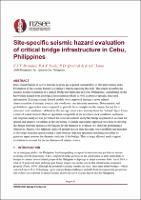| dc.contributor.author | Bernales, Francis Jenner | |
| dc.contributor.author | Selda, Patrick Adrian | |
| dc.contributor.author | Quebral, Ramon | |
| dc.contributor.author | Luna, Roy Anthony | |
| dc.date.accessioned | 2023-08-28T04:23:37Z | |
| dc.date.available | 2023-08-28T04:23:37Z | |
| dc.date.issued | 2023-04-19 | |
| dc.identifier.uri | https://repo.nzsee.org.nz/xmlui/handle/nzsee/2618 | |
| dc.description.abstract | Long-span, inter-island bridges in active tectonic regions are exposed considerably to elevated seismic risks. Evaluation of the seismic hazard is a primary step to assess this risk. Baseline information can be obtained from national (or regional) hazard studies but features unique to the site and structure are not precisely captured. This paper describes the seismic hazard evaluation of a critical bridge infrastructure in Cebu, Philippines, capitalizing on the knowledge gained from geological investigation efforts as well as project-specific structural information.
Existing seismic hazard models were improved through a more refined characterization of seismic sources, site conditions, and intensity measures. Deterministic and probabilistic approaches were compared to provide better insights on the seismic hazard for a reference rock condition—defined herein as the average shear wave velocity from ‘refusal’ or beginning of the rock layer. From a suite of scaled motions that are compatible with the 5%-damped spectral accelerations at the reference rock condition, nonlinear site response analysis with Monte Carlo simulation was performed for several locations along the bridge alignment to account for spatial and aleatory variability in the site terms. A simple smoothing approach was done to develop the design response spectra at two hazard levels intended to evaluate two different performance objectives.
Finally, two different suites of ground motion time-histories are modified and matched to the target response spectra using a time-domain response spectrum matching procedure to generate input motions for dynamic analysis of the bridge. This strategy allowed multi-support excitation to account for incoherence of seismic waves. | |
| dc.language.iso | en | |
| dc.publisher | New Zealand Society for Earthquake Engineering | |
| dc.relation.ispartofseries | 2023;53 | |
| dc.subject | Understanding seismic hazard and risk | |
| dc.title | Site-specific seismic hazard evaluation of critical bridge infrastructure in Cebu, Philippines | |
| dc.type | Article | |

